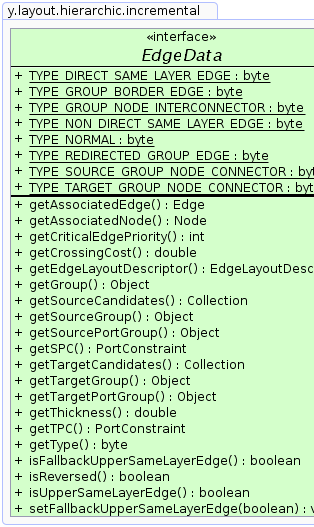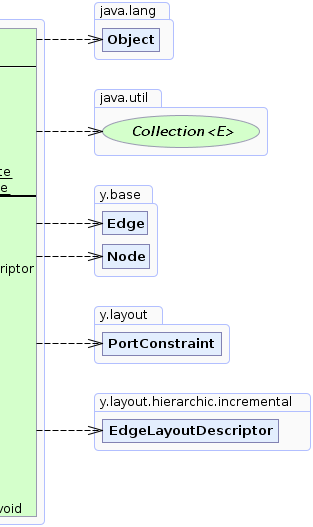 |
 |
|
Search this API | ||||||||
| PREV CLASS NEXT CLASS | FRAMES NO FRAMES | ||||||||
| SUMMARY: NESTED | FIELD | CONSTR | METHOD | DETAIL: FIELD | CONSTR | METHOD | ||||||||
public interface EdgeData
This interface provides layout information about the edges of the graph during the layout.
EdgeData is a multi-purpose edge descriptor for each edge, holding information about the
type of an edge, associated port constraints,
port candidates, edge groups as well as the current edge state.
It is used in all phases of the HierarchicLayouter to store edge information.
 |
 |
| Field Summary | |
|---|---|
static byte |
TYPE_DIRECT_SAME_LAYER_EDGE
A constant describing a same-layer edge that connects directly two neighboring nodes. |
static byte |
TYPE_GROUP_BORDER_EDGE
A constant describing an edge that connects group border nodes in adjacent layers. |
static byte |
TYPE_GROUP_NODE_INTERCONNECTOR
A constant describing an edge that connects two group nodes. |
static byte |
TYPE_NON_DIRECT_SAME_LAYER_EDGE
A constant describing a same-layer edge that does not connect directly two neighboring nodes. |
static byte |
TYPE_NORMAL
A constant describing a normal edge. |
static byte |
TYPE_REDIRECTED_GROUP_EDGE
A constant describing an edge that has been added temporarily to replace an edge connected to a group node. |
static byte |
TYPE_SOURCE_GROUP_NODE_CONNECTOR
A constant describing an edge that connects to a source group node. |
static byte |
TYPE_TARGET_GROUP_NODE_CONNECTOR
A constant describing an edge that connects to a target group node. |
| Method Summary | |
|---|---|
Edge |
getAssociatedEdge()
Returns the Edge associated with this EdgeData instance. |
Node |
getAssociatedNode()
Returns the Node associated with this EdgeData instance. |
int |
getCriticalEdgePriority()
Returns the critical edge priority of the Edge associated with this EdgeData instance. |
double |
getCrossingCost()
Returns the crossing cost of the Edge associated with this EdgeData instance. |
EdgeLayoutDescriptor |
getEdgeLayoutDescriptor()
Returns the EdgeLayoutDescriptor instance bound to the Edge associated with this
EdgeData instance. |
java.lang.Object |
getGroup()
Returns the group that is represented by the Edge associated with this EdgeData
instance. |
java.util.Collection |
getSourceCandidates()
Returns the collection of PortCandidates for the source port of the
Edge associated with this EdgeData instance. |
java.lang.Object |
getSourceGroup()
Returns the ID of the edge group at the source node to which the Edge associated with this EdgeData
instance belongs (if any). |
java.lang.Object |
getSourcePortGroup()
Returns the ID of the edge port group at the source node to which the Edge associated with this
EdgeData instance belongs (if any). |
PortConstraint |
getSPC()
Returns the port constraints for the source port of the Edge associated with this
EdgeData instance. |
java.util.Collection |
getTargetCandidates()
Returns the collection of PortCandidates for the target port of the
Edge associated with this EdgeData instance. |
java.lang.Object |
getTargetGroup()
Returns the ID of the edge group at the target node to which the Edge associated with this EdgeData
instance belongs (if any). |
java.lang.Object |
getTargetPortGroup()
Returns the ID of the edge port group at the target node to which the Edge associated with this EdgeData
instance belongs (if any). |
double |
getThickness()
Returns the thickness of the Edge associated with this EdgeData instance. |
PortConstraint |
getTPC()
Returns the port constraints for the target port of the Edge associated with this
EdgeData instance. |
byte |
getType()
Returns the type of the Edge associated with this EdgeData instance. |
boolean |
isFallbackUpperSameLayerEdge()
Returns whether or not the Edge associated with this EdgeData instance should be an upper
same-layer edge (if it is a same-layer edge). |
boolean |
isReversed()
Returns whether or not the Edge associated with this EdgeData instance has been reversed. |
boolean |
isUpperSameLayerEdge()
Returns whether or not the Edge associated with this EdgeData instance is an upper same-layer edge. |
void |
setFallbackUpperSameLayerEdge(boolean fallback)
Specifies whether or not the Edge associated with this EdgeData instance should be an upper
same-layer edge (if it is a same-layer edge). |
| Field Detail |
|---|
static final byte TYPE_NORMAL
getType(),
Constant Field Valuesstatic final byte TYPE_SOURCE_GROUP_NODE_CONNECTOR
getType(),
Constant Field Valuesstatic final byte TYPE_TARGET_GROUP_NODE_CONNECTOR
getType(),
Constant Field Valuesstatic final byte TYPE_GROUP_NODE_INTERCONNECTOR
getType(),
Constant Field Valuesstatic final byte TYPE_DIRECT_SAME_LAYER_EDGE
getType(),
Constant Field Valuesstatic final byte TYPE_NON_DIRECT_SAME_LAYER_EDGE
This means that two nodes of the same layer are not connected directly with a straight-line edge, but with an edge consisting of polyline segments.
getType(),
Constant Field Valuesstatic final byte TYPE_GROUP_BORDER_EDGE
getType(),
Constant Field Valuesstatic final byte TYPE_REDIRECTED_GROUP_EDGE
getType(),
Constant Field Values| Method Detail |
|---|
byte getType()
Edge associated with this EdgeData instance.
EdgeNode getAssociatedNode()
Node associated with this EdgeData instance.
If no Node is associated with this EdgeData instance, null should be returned.
Node or null no such Node existsEdge getAssociatedEdge()
Edge associated with this EdgeData instance.
If no Edge is associated with this EdgeData instance, null should be returned.
Edge or null no such Edge existsPortConstraint getSPC()
port constraints for the source port of the Edge associated with this
EdgeData instance.
PortConstraints are obtained by a DataProvider
registered with the graph with key PortConstraintKeys.SOURCE_PORT_CONSTRAINT_KEY.
PortConstraint instance for the source portjava.lang.Object getSourcePortGroup()
Edge associated with this
EdgeData instance belongs (if any).
Information about edge port grouping at the source node is obtained by a DataProvider
registered with the graph with key PortConstraintKeys.SOURCE_PORT_GROUP_ID_DPKEY.
java.util.Collection getSourceCandidates()
collection of PortCandidates for the source port of the
Edge associated with this EdgeData instance.
Source port candidates are obtained by a DataProvider
registered with the graph with key PortCandidate.SOURCE_PCLIST_DPKEY.
collection of PortCandidate for the source portPortConstraint getTPC()
port constraints for the target port of the Edge associated with this
EdgeData instance.
PortConstraints are obtained by a DataProvider
registered with the graph with key PortConstraintKeys.TARGET_PORT_CONSTRAINT_KEY.
PortConstraint instance for the target portjava.lang.Object getTargetPortGroup()
Edge associated with this EdgeData
instance belongs (if any).
Information about edge port grouping at the target node is obtained by a DataProvider
registered with the graph with key PortConstraintKeys.TARGET_PORT_GROUP_ID_DPKEY.
java.util.Collection getTargetCandidates()
collection of PortCandidates for the target port of the
Edge associated with this EdgeData instance.
Target port candidates are obtained by a DataProvider
registered with the graph with key PortCandidate.TARGET_PCLIST_DPKEY.
collection of PortCandidate for the target portjava.lang.Object getSourceGroup()
Edge associated with this EdgeData
instance belongs (if any).
Information about edge grouping at the source node is obtained by a DataProvider
registered with the graph with key PortConstraintKeys.SOURCE_GROUPID_KEY.
java.lang.Object getTargetGroup()
Edge associated with this EdgeData
instance belongs (if any).
Information about edge grouping at the target node is obtained by a DataProvider
registered with the graph with key PortConstraintKeys.TARGET_GROUPID_KEY.
java.lang.Object getGroup()
Edge associated with this EdgeData
instance.
Edgeboolean isReversed()
Edge associated with this EdgeData instance has been reversed.
true if the associated Edge has been reversed, false otherwiseboolean isUpperSameLayerEdge()
Edge associated with this EdgeData instance is an upper same-layer edge.
An upper same-layer edge is an edge connecting two nodes of the same layer with polyline segments (not directly, with a straight-line) and is routed above the layer.
true if the associated Edge is an upper same-layer edge, false otherwiseEdgeLayoutDescriptor getEdgeLayoutDescriptor()
EdgeLayoutDescriptor instance bound to the Edge associated with this
EdgeData instance.
If no EdgeLayoutDescriptor is bound to the edge, null should be returned.
EdgeLayoutDescriptor instance or null if no EdgeLayoutDescriptor is
registeredvoid setFallbackUpperSameLayerEdge(boolean fallback)
Edge associated with this EdgeData instance should be an upper
same-layer edge (if it is a same-layer edge).
An upper same-layer edge is an edge connecting two nodes of the same layer with polyline segments (not directly, with straight-line) and is routed above the layer.
If enabled the edge will be routed above the layer, otherwise below it.
fallback - true if the same-layer edge should be routed above the layer, false
otherwiseboolean isFallbackUpperSameLayerEdge()
Edge associated with this EdgeData instance should be an upper
same-layer edge (if it is a same-layer edge).
An upper same-layer edge is an edge connecting two nodes of the same layer with polyline segments (not directly, with a straight-line) and is routed above the layer.
If enabled the edge will be routed above the layer, otherwise below it.
true if the same-layer edge should be routed above the layer, false otherwisesetFallbackUpperSameLayerEdge(boolean)double getThickness()
Edge associated with this EdgeData instance.
The thickness is considered when calculating minimum distances so that there are no overlaps between edges and other graph elements.
The thickness must have a non-negative value.
double getCrossingCost()
Edge associated with this EdgeData instance.
The crossings costs of edges are considered when minimizing the edge crossing count during the sequencing phase.
int getCriticalEdgePriority()
Edge associated with this EdgeData instance.
The layout algorithm tries to vertically align each node pair that is connected by a critical edge. Conflicts between different critical edges are always resolved in favor of the edge with the higher priority.
|
© Copyright 2000-2025, yWorks GmbH. All rights reserved. |
||||||||
| PREV CLASS NEXT CLASS | FRAMES NO FRAMES | ||||||||
| SUMMARY: NESTED | FIELD | CONSTR | METHOD | DETAIL: FIELD | CONSTR | METHOD | ||||||||